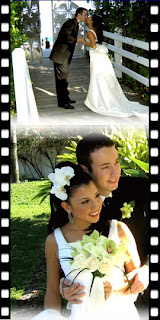
Creating a wedding video is a great way to capture the memories of your special day. Unlike pictures, a video can capture the feelings of the ceremony, allowing you to relive the mood and special events of the celebration each time you watch your recorded memories.
While most people have a friend or family member taping the ceremony, it may be a good idea to hire a professional videographer to capture the ceremony in a way that may have a little more structure. You can request that your wedding day events be formatted to look like a movie, or you can go for more of a documentary feel. Also, a videographer will be able to put finishing production touches on your video that will make the colors brighter--they can even add credits! The videographer will most likely tape the whole celebration, from the actual ceremony, until the bride and groom depart at the reception. You could request that scenes or conversations before the ceremony be taped, such as the bride and groom getting ready, or having loved ones send their well wishes to the couple before the ceremony begins. Wedding videos can also include a picture of the invitation, old family photographs, baby pictures of the bride and groom, or messages from the bride and groom to one another. This, along with the raw footage that will be gathered at the reception, should give you a 'feature film' of about two hours.
Of course, you'll want the sounds and music that are included in the video to be just as beautiful as the scenery. This is why it's so important to choose the right wedding songs for each part of the ceremony. Be sure that you practice to these songs so that the footage that is gathered looks both polished and natural. For the actual ceremony, original songs are ideal. Also, you'll need a recessional song to exit the chapel. Make sure that you tell your videographer when you want the songs to fade out, and how much of the tunes you want played so that you can maintain the flow of your video.
Also, confirm that the videographer has the quality equipment that will make your video look its best. Video equipment that requires less lighting is best (usually commercial-grade), so that there won't be a glare on the images in the video. This is especially important for the candle lighting part of the ceremony, and for the first dances between the new couple and the bride and her father. When you're looking at the videographer's work, make sure that you not only look for the focus and tracking quality of the video, but check for artistic quality as well. Is the videographer good at capturing timeless moments on film? Is he/she good at making transitions throughout the video? Including wedding music in between 'scenes' and in the background as people are speaking may also help the video to 'flow' a little more naturally.
By E. Walter Smith.
While most people have a friend or family member taping the ceremony, it may be a good idea to hire a professional videographer to capture the ceremony in a way that may have a little more structure. You can request that your wedding day events be formatted to look like a movie, or you can go for more of a documentary feel. Also, a videographer will be able to put finishing production touches on your video that will make the colors brighter--they can even add credits! The videographer will most likely tape the whole celebration, from the actual ceremony, until the bride and groom depart at the reception. You could request that scenes or conversations before the ceremony be taped, such as the bride and groom getting ready, or having loved ones send their well wishes to the couple before the ceremony begins. Wedding videos can also include a picture of the invitation, old family photographs, baby pictures of the bride and groom, or messages from the bride and groom to one another. This, along with the raw footage that will be gathered at the reception, should give you a 'feature film' of about two hours.
Of course, you'll want the sounds and music that are included in the video to be just as beautiful as the scenery. This is why it's so important to choose the right wedding songs for each part of the ceremony. Be sure that you practice to these songs so that the footage that is gathered looks both polished and natural. For the actual ceremony, original songs are ideal. Also, you'll need a recessional song to exit the chapel. Make sure that you tell your videographer when you want the songs to fade out, and how much of the tunes you want played so that you can maintain the flow of your video.
Also, confirm that the videographer has the quality equipment that will make your video look its best. Video equipment that requires less lighting is best (usually commercial-grade), so that there won't be a glare on the images in the video. This is especially important for the candle lighting part of the ceremony, and for the first dances between the new couple and the bride and her father. When you're looking at the videographer's work, make sure that you not only look for the focus and tracking quality of the video, but check for artistic quality as well. Is the videographer good at capturing timeless moments on film? Is he/she good at making transitions throughout the video? Including wedding music in between 'scenes' and in the background as people are speaking may also help the video to 'flow' a little more naturally.
By E. Walter Smith.





0 comments:
Post a Comment